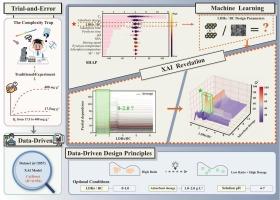What governs phosphorus adsorption on biochar-supported layered double hydroxides? A data-driven analysis of parameter interactions
IF 9
1区 工程技术
Q1 ENGINEERING, CHEMICAL
引用次数: 0
Abstract
The rational design of advanced functional materials, such as adsorbents for tackling water eutrophication, is often challenged by inconsistent experimental findings and a lack of generalizable design principles. This difficulty stems from the complex nature of these materials, where performance is dictated by the non-linear interplay of numerous synthesis and operational parameters that traditional trial-and-error methods cannot adequately resolve. This study presents a systematic explainable AI (XAI) framework to move beyond simple prediction and instead deconstruct the complex structure-performance relationships in biochar-supported layered double hydroxide composites (LDH@BC). Leveraging a 2057-point literature dataset, our high-accuracy CatBoost model (R2 = 0.956) serves as a reliable foundation for this in-depth analysis. The analysis identified a set of optimal operating conditions, including a solution pH of 4–7 and an adsorbent dosage of 1.0–2.0 g·L−1. Crucially, the model also revealed a key design principle: a low LDHs/BC ratio (0–1.0), combined with sufficient adsorbent dosages, maximizes adsorption capacity by promoting optimal nanoparticle dispersion. This work provides not only specific, data-driven guidelines for the rational design of LDH@BC adsorbents but also demonstrates a transferable XAI framework for accelerating the transition from empirical screening to intelligent, data-informed design for other complex functional materials.

是什么控制着磷在生物炭负载的层状双氧水化物上的吸附?参数相互作用的数据驱动分析
先进功能材料的合理设计,如用于解决水富营养化的吸附剂,经常受到不一致的实验结果和缺乏可推广的设计原则的挑战。这种困难源于这些材料的复杂性,其性能取决于许多合成和操作参数的非线性相互作用,而传统的试错方法无法充分解决这些问题。本研究提出了一个系统的可解释的人工智能(XAI)框架,超越了简单的预测,而是解构了生物炭支撑的层状双氢氧化物复合材料中复杂的结构-性能关系(LDH@BC)。利用2057点的文献数据集,我们的高精度CatBoost模型(R2 = 0.956)为深入分析提供了可靠的基础。分析确定了一组最佳操作条件,包括溶液pH为4-7,吸附剂用量为1.0-2.0 g·L−1。重要的是,该模型还揭示了一个关键的设计原则:低LDHs/BC比(0-1.0),结合足够的吸附剂剂量,通过促进最佳的纳米颗粒分散来最大化吸附容量。这项工作不仅为LDH@BC吸附剂的合理设计提供了具体的、数据驱动的指导方针,而且还展示了一个可转移的XAI框架,用于加速从经验筛选到其他复杂功能材料的智能、数据通知设计的过渡。
本文章由计算机程序翻译,如有差异,请以英文原文为准。
求助全文
约1分钟内获得全文
求助全文
来源期刊

Separation and Purification Technology
工程技术-工程:化工
CiteScore
14.00
自引率
12.80%
发文量
2347
审稿时长
43 days
期刊介绍:
Separation and Purification Technology is a premier journal committed to sharing innovative methods for separation and purification in chemical and environmental engineering, encompassing both homogeneous solutions and heterogeneous mixtures. Our scope includes the separation and/or purification of liquids, vapors, and gases, as well as carbon capture and separation techniques. However, it's important to note that methods solely intended for analytical purposes are not within the scope of the journal. Additionally, disciplines such as soil science, polymer science, and metallurgy fall outside the purview of Separation and Purification Technology. Join us in advancing the field of separation and purification methods for sustainable solutions in chemical and environmental engineering.
 求助内容:
求助内容: 应助结果提醒方式:
应助结果提醒方式:


